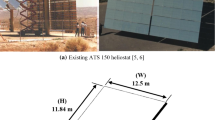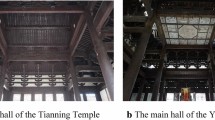Abstract
Heliostats are sensitive to the wind load, thus as a key indicator, the study on the static and dynamic stability bearing capacity for heliostats is very important. In this work, a numerical wind tunnel was established to calculate the wind load coefficients in various survival stow positions. In order to explore the best survival stow position for the heliostat under the strong wind, eigenvalue buckling analysis method was introduced to predict the critical wind load theoretically. Considering the impact of the nonlinearity and initial geometrical imperfection, the nonlinear post-buckling behaviors of the heliostat were investigated by load-displacement curves in the full equilibrium process. Eventually, combining B-R criterion with equivalent displacement principle the dynamic critical wind speed and load amplitude coefficient were evaluated. The results show that the determination for the best survival stow position is too hasty just by the wind load coefficients. The geometric nonlinearity has a great effect on the stability bearing capacity of the heliostat, while the effects of the material nonlinearity and initial geometrical imperfection are relatively small. And the heliostat is insensitive to the initial geometrical imperfection. In addition, the heliostat has the highest safety factor for wind-resistant performance in the stow position of 90-90 which can be taken as the best survival stow position. In this case, the extreme survival wind speeds for the static and dynamic stability are 150 m/s and 36 m/s, respectively.
Similar content being viewed by others
References
KOLB G J, JONES S A, DONNELLY M W, GORMAN D, THOMAS R, DAVENPORT R, LUMIA R. Heliostat cost reduction study[R]. New Mexico: Sandia National Laboratories, 2007.
COVENTRY J, PYE J. Heliostat cost reduction-where to now? [C]// PITCHUMANI R. Energy Procedia. Amsterdam, Netherland: Elsevier Science BV, 2013: 60–70.
YELLOWHAIR J, ANDRAKA C E. Evaluation of advanced heliostat reflective facets on cost and performance [C]// PITCHUMANI R. Energy Procedia. Amsterdam, Netherland: Elsevier Science BV, 2013: 265–274.
SUN Hong-hang, GONG Bo, YAO Qiang. A review of wind loads on heliostat and trough collectors [J]. Renewable and Sustainable Energy Reviews, 2014, 32: 206–221.
PETERKA J A, HOSOYA N, BIENKIEWICZ B, CERMAK J E. Wind load reduction for heliostats [R]. Colorado: Colorado State University, 1986.
PETERKA J A, TAN Z, BIENKIEWICZ B, CERMAK J E. Mean and peak wind load reduction on heliostats [R]. Colorado: Colorado State University, 1987.
PETERKA J A, TAN Z, BIENKIEWICZ B, CERMAK J E. Wind loads on heliostats and parabolic dish collectors [R]. Colorado: Colorado State University, 1988.
PFAHL A, UHLEMANN H. Wind loads on heliostats and photovoltaic trackers at various Reynolds numbers [J]. Journal of Wind Engineering and Industrial Aerodynamics, 2011, 99: 964–968.
PFAHL A, BUSELMEIER M, ZASCHKE M. Wind loads on heliostats and photovoltaic trackers of various aspect ratios [J]. Solar Energy, 2011, 85: 2185–2201.
PFAHL A, BRUCKS A, HOLZE C. Wind load reduction for light-weight heliostats [C]// PITCHUMANI R. Energy Procedia. Amsterdam, Netherland: Elsevier Science BV, 2013: 193–200.
GONG Bo, WANG Zhi-feng, LI Zheng-nong, ZANG Chun-cheng, WU Zhi-yong. Fluctuating wind pressure characteristics of heliostats [J]. Renewable Energy, 2013, 50: 307–316.
GONG Bo, LI Zheng-nong, WANG Zhi-feng, WANG Ying-ge. Wind-induced dynamic response of heliostat [J]. Renewable Energy, 2012, 38: 206–213.
ZANG Chun-cheng, GONG Bo, WANG Zhi-feng. Experimental and theoretical study of wind loads and mechanical performance analysis of heliostats [J]. Solar Energy, 2014, 105: 48–57.
BLACKMON J B. Heliostat drive unit design considerations-site wind load effects on projected fatigue life and safety factor [J]. Solar Energy, 2014, 105: 170–180.
DAVENPORT A G. The relationship of wind structures to wind loading [R]. Teddington, Middlesex: National Physical Laboratory, 1965: 54–102.
ZHANG Xiang-ting. Calculation of structural wind pressure and wind vibration [M]. Shanghai: Tongji University Press, 1985. (in Chinese).
GB50009-2012. Ministry of housing and urban-rural development of the PRC. load code for the design of building structures [S]. 2012. (in Chinese)
European Convention for Constructional Steelwork, Technical Committee. T12: Wind effects recommendations for the calculation of wind effects on buildings and structures [S]. 1978.
DEML M, WUNDERLICH W. Direct evaluation of the “worst” imperfection shape in shell buckling [J]. Computer Methods in Applied Mechanics and Engineering, 1997, 149: 201–222.
CHEN Xin, SHEN Shi-zhao. Complete load-deflection response and initial imperfection analysis of single-layer lattice dome [J]. International Journal of Space Structures, 1993, 8(4): 271–278.
American Institute of Steel Construction. ANSI/AISC, No. 360-05 Specification for Structural Steel Buildings[S]. 2005.
ZHI Xu-dong, FAN Feng, SHEN Shi-zhao. Elasto-plastic instability of single-layer reticulated shells under dynamic actions [J]. Thin-Walled Structures, 2010, 48: 837–845.
BUDIANSKY B, ROTH R S. Axisymmetric dynamic buckling of clamped shallow spherical shells [R]. Washington D C: NASA, 1962.
VAMVATSIKOS D, CORNELL C A. Incremental dynamic analysis [J]. Earthquake Engineering & Structural Dynamic, 2002, 31(3): 491–514.
VERSTEEG H K, MALALASEKERA W. An introduction to computational fluid dynamics: The finite volume method [M]. Second Edition. New Jersey: Prentice Hall, 2007.
PETERKA J A, DERICKSON R G. Wind load design methods for ground-based heliostats and parabolic dish collectors [R]. Colorado: Colorado State University, 1992.
RAHMAN S M, HASSAN T, CORONA E. Evaluation of cyclic plasticity models in ratcheting simulation of straight pipes under cyclic bending and steady internal pressure [J]. International Journal of Plasticity, 2008, 24(10): 1756–1791.
FORDE W R B, STIEMER S F. Improved arc length orthogonality methods for nonlinear finite element analysis [J]. Computers and Structures, 1987, 27(5): 625–630.
LI Jin-hua, LI Chun-xiang. Development of numerical simulations for stochastic wind fields in civil engineering [J]. Journal of Vibration and Shock, 2008, 27(9): 116–125. (in Chinese).
OWEN J S, ECCLES B J, CHOO B S, WOODINGS M A. The application of auto-regressive time series modelling for the timefrequency analysis of civil engineering structures [J]. Engineering Structures, 2001, 23: 521–536.
IANNUZZI A, SPINELLI P. Artificial wind generation and structural response [J]. Journal of Structure Engineering, 1987, 113(12): 2382–2398.
LI Yuan-qi, TAMURA Y. Nonlinear dynamic analysis for large-span single-layer reticulated shells subjected to wind loading [J]. Wind and Structures, 2005, 8(1): 35–48.
CUTTING F M. Heliostat survivability and structural stability for wind loading [C]// Alternative Energy Sources. Washington D C: Hemisphere Publishing Corp, 1978: 463–525.
Author information
Authors and Affiliations
Corresponding author
Additional information
Foundation item: Project(CYB14010) supported by Chongqing Graduate Student Research Innovation Project, China; Project(51405209) supported by the National Natural Science Foundation of China
Rights and permissions
About this article
Cite this article
Feng, Y., Chen, Xa. & Shan, Wt. Evaluation of survival stow position and stability analysis for heliostat under strong wind. J. Cent. South Univ. 23, 3006–3017 (2016). https://doi.org/10.1007/s11771-016-3364-x
Received:
Accepted:
Published:
Issue Date:
DOI: https://doi.org/10.1007/s11771-016-3364-x




